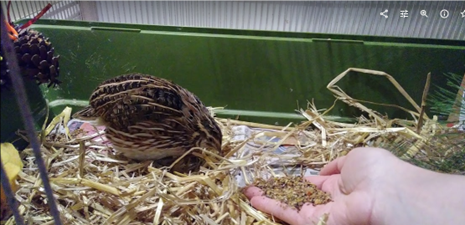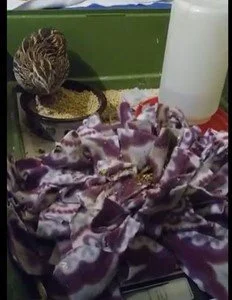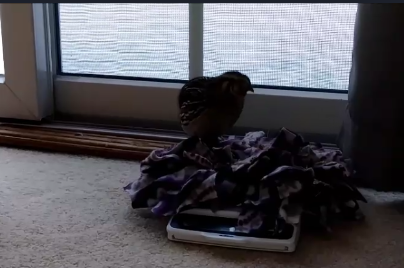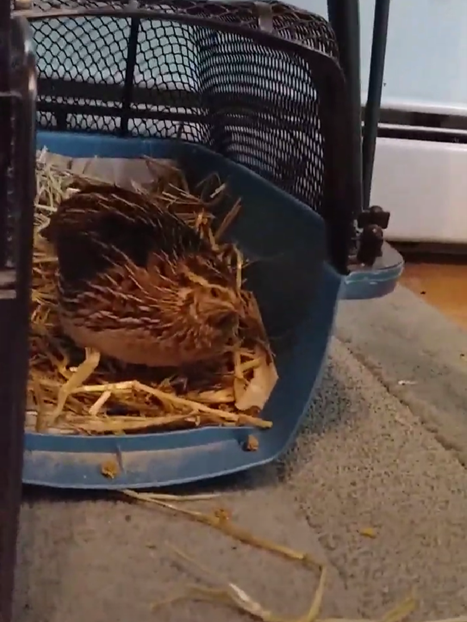Training a Quail
by Sheila S. Blanchette, IAABC-CPBC, UW-AAB, Director of Education, Rhode Island Parrot Rescue
As a Certified Companion Bird Behavior Consultant Trainer, I have had opportunities to train various companion birds, from Budgerigars to Yellow-Streak Lorikeets. I was recently asked “What was the most interesting species of birds have you trained?” The answer: “Coturnix Quail.” The following article is about using “Choice Training/Positive Reinforcement Training” when training a quail. It is also important to remember, “Any bird can learn.”
I was in a situation where there was a call for assistance on a quail; I was up for the challenge. Before connecting with Rhode Island Parrot Rescue, I would foster specific companion birds for adoption. I completed my project on fostering companion birds back in 2020 and have retired from fostering companion birds. Cricket, the Coturnix Quail, was one of my most interesting in the Foster Program Project.
Cricket the Coturnix Quail
Coturnix quails are popular domestic birds. Quails thrive in a flock consisting of one male and several females. Those who keep quails raise the females for their eggs and keep a male to protect the flock. Cricket, a 2-year-old male, no longer had females to protect. Cricket was a lone quail; there was concern about aggression or other behaviors that could occur if the bird became a companion bird.
Figure 1: A 2-year-old Male Coturnix Quail named Cricket.
Resetting the Environment
Cricket's original indoor setup environment was a rabbit cage with food, water, and straw.
Figure 2: Cricket in a Rabbit Cage
Figure 3: Cricket in the brush
When Cricket settled into this setup, he started becoming very skittish. Brush was added the enclosure, which gave Cricket a place to hide and rest.
Forage Training
The start training began with figuring out Cricket’s favorite food so foraging could be introduced in the enclosure. To discover Cricket’s favorite food item, several different food items were placed in the food bowl: chicken feed, millet, mealworms (live and dehydrated), and chopped-up vegetables.
By logging each day, the food Cricket enjoyed eating first and which items were kicked to the side (literally) gave an insight into Cricket’s favorite food items; these food items were removed from the food bowl. Millet and mealworms became the training food. To verify, pieces of millet and mealworms were hidden in his straw to encourage foraging behavior. After a month, I could hide his favorite food in the straw, and Cricket was fantastic at finding his favorite food.
Figure 4: Cricket Foraging
Over the month, the rabbit cage became too small to encourage foraging. I enlarged the enclosure to 5 feet by 5 feet. I continued to hide the daily meal in the new brush or under dandelion greens. Cricket was always searching for food (and those mealworms).
Figure 5: Cricket’s larger enclosure
Weight Training
Part 1: Mat Training
Cricket began to prefer to search for food rather than eat the food in his food bowl. As part of starting weight training, the first step was introducing a foraging mat (a dog snuffle mat). Each day, I placed the foraging mat into the enclosure, which had day-to-day food and mealworms hidden in it. It did not take long for Cricket to start investigating the foraging mat.
Figure 6: Introduction of Foraging Mat
In about a week, Cricket began standing on top of the foraging mat, and once in a while, Cricket would sit on top of the mat crowing (Hear Cricket Quail crowing - https://youtu.be/HprqQGeO0ZU).
Figure 7: Cricket standing on the Forage mat
Cricket became more and more comfortable with the forage mat. The mate could be moved anywhere, and Cricket would find the mat and forage for mealworms.
Figure 8: Cricket foraging outside the cage
Part 2: Adding the Scale
The next step in weight training is getting the quail on the scale. The scale is tucked under the mat to start. The goal is not to get the weight (just yet); continue the forage mat training.
Figure 9: Adding scale to the mat training
There was No Force, No Stress, just reinforcing the foraging mat.
Over time, the mat could be placed on the scale, so the numbers were visible. Weight Training became so much easier. Cricket enjoyed jumping up to higher spots.
Figure 10: Volunteering to get up on the scale
Crate Training
Cricket enjoyed exploring outside of the cage and jumping into his sandbox to take a sand bath. Quails love sand baths (Video of Cricket taking a Sand bath - https://youtube.com/shorts/QdJpVXSjSQ4?feature=share).
Cricket enjoyed the training and exploring the house. Cricket would hang with us around the house, especially out on our screened porch.
Figure 11: Cricket out on the screened porch
The next training was Crate training. The training started with the crate being in the room.
Figure 12: Crate in the Area
The crate was filled with straw and mealworms. Cricket found the crate not long after keeping it on the floor and he began hanging out in it.
Figure 13: Cricket in the Crate in the Area
All the exercises, from foraging to crate training, took approximately three months. He never showed aggressive behavior and was a fantastic learner.
Epilogue
Cricket was in the foster program for six months until we decided to adopt him. He was a great learner but also a great teacher. Cricket was trained to be an educational bird, and he visited several local technical schools that had Veterinary Science programs. He showed off his mat, scale, and crate training in the classroom. Sadly, he passed away with being us for only a year. Cricket will be remembered and honored as a Smart Little Quail who loved his sand baths.
Copyrighted. Blog posts may be used as guidelines for the proper care of your parrot. Not intended for medical or legal advice. Please consult with a licensed avian veterinarian regarding the medical care and wellbeing of your exotic pets.













